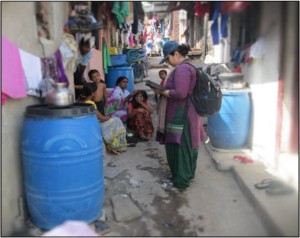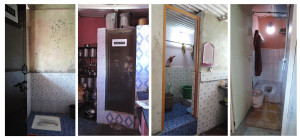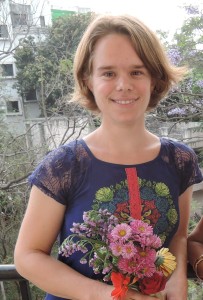 Shelter Associates (SA) has been providing housing and sanitation to the urban poor fr over 23 years. Since 2010, individual sanitation has been delivered in a structured and focused manner in vulnerable slums. The process of facilitating household toilets was initiated with extensive data collection and analysis at each stage. The collected data formed the foundation of a pragmatic approach, ensuring feasibility of interventions, as well as an efficient and optimum use of funds. The data collection is carried out with help of the following surveys:
Shelter Associates (SA) has been providing housing and sanitation to the urban poor fr over 23 years. Since 2010, individual sanitation has been delivered in a structured and focused manner in vulnerable slums. The process of facilitating household toilets was initiated with extensive data collection and analysis at each stage. The collected data formed the foundation of a pragmatic approach, ensuring feasibility of interventions, as well as an efficient and optimum use of funds. The data collection is carried out with help of the following surveys:
- Rapid Infrastructure Mapping – mapping of existing infrastructure of slum
- Rapid Infrastructure factsheet – profiling of slum
- Rapid Household Surveys – collecting household level data
- Individual factsheet – for maintaining record of completed toilets
SA used a web-based application for data entry and creating reports (using collected data) and an android app for data collection of the above mentioned surveys. Data collection is an ongoing process. With the expansion of our operations in new cities, the survey forms and data collection systems need a continuous update. It was possible to modify the existing platform too, but very little. SA and its IT partner Soft-Corner were thus exploring new ways to incorporate the requirement. Meanwhile, Mr. Donald Lobo suggested an open source platform called Kobo Toolbox for defining and deploying surveys and for collecting data.
KoboToolbox, a set of open source software tools, seemed quite suitable for our requirements. Soft-Corner also verified it by running a few tests on it for the same. SA has started its work in a new city recently – Navi Mumbai – where Kobo Toolbox is being used for data collection and entry. We have found it pretty user friendly and time saving while also allowing customization. Our initial experience in using this new tool was very good.
- Benefits at a glance
Mobile application
The survey can be deployed on mobile devices very easily
The entered data can be edited
The earlier app allowed uploading of responses one at a time. This allows all at one go (or one or multiple by choosing which ones to upload)
Web application
A lot of options in the definition of different types of questions – including validation rules and skip patterns, save time on the field and increase the accuracy of the data collected.
Grouping questions enable us to view them on a single page.
Repetition of a set of questions is possible, based on a value (for example – if there are 3 community toilets, then the same set of questions about the community toilets are asked 3 times – once for each community toilet)
Data can be viewed and edited in code or label format
Data downloading in various formats is possible.We can also view and download photos captured using the mobile app
Data analysis is made easier - Challenges
Here is a wish list of what more we would have liked
1. We cannot add a question to the existing form and if we do, we have to redeploy it and redeployment means losing existing data.
2. As far as our understanding, there is no provision of having long integer data type
Skip patterns cannot be given based on the values of certain options of a question
3. The exported excel needs formatting. (-).
4. There seems to be no provision to auto copy a field from the previous response – like the slum name. If we have to enter 50 responses, each time we have to enter the slum name.)
5. There seems to be no provision for re-edits from the mobile device after uploading the data to the server. This could potentially lead to a problem. For example – if we have uploaded the data of household number 23 (improperly) and at some later date, I enter the correct 23, we cannot edit the previously uploaded data from the mobile device. we have to do it from the web module.
6. When a response is entered on the mobile device for a survey form, it asks for a name by which it would save the response on the mobile device. However, there is no format or validation rule that can be given for this name – which essentially means that each data person collecting the data can give the name of their choice. It would be more organized if we could give a pattern to force the naming in a certain way. Or alternatively, if we can pick some field(s) from the current response (like household number and the status) and show that as the default name to save the response, it would be very convenient.
7. The above mentioned name (by which the response is saved on the mobile device) is not available eventually – both at the back end and in the exported data. Its use is only till we upload the data. If that name is available for the record that could help.






 oilet in each of the 60,000 potential slum homes, it will cost approximately 121 Cr. Through a partnership between Pune Municipal Corporation, private companies and citizens this goal can be achieved in the next 5 years and Pune could be the first city to become ODF and establish a partnership model that can be emulated by other states as well.”
oilet in each of the 60,000 potential slum homes, it will cost approximately 121 Cr. Through a partnership between Pune Municipal Corporation, private companies and citizens this goal can be achieved in the next 5 years and Pune could be the first city to become ODF and establish a partnership model that can be emulated by other states as well.”